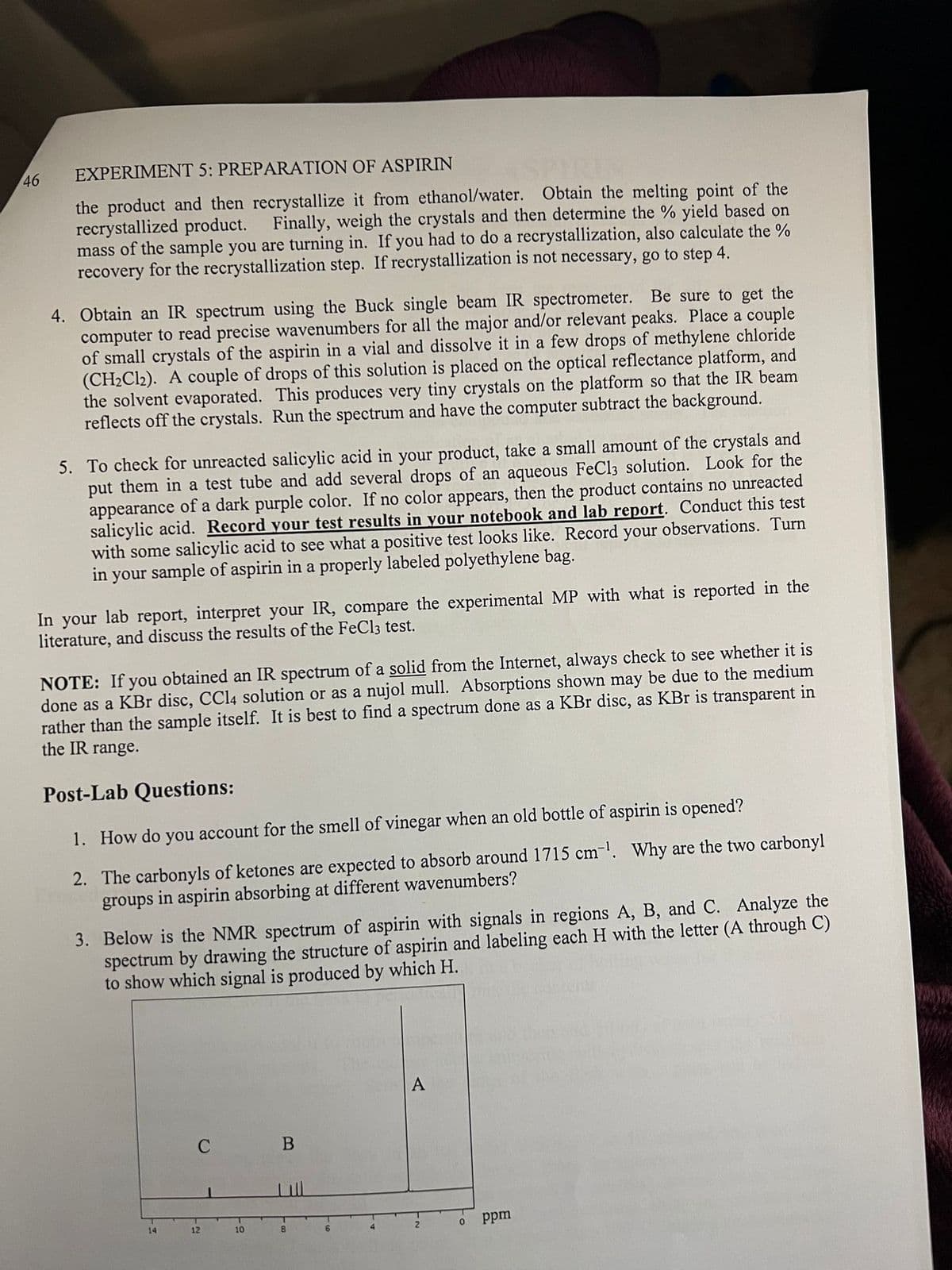1. How do you account for the smell of vinegar when an old bottle of aspi 2. The carbonyls of ketones are expected to absorb around 1715 cm-¹. Why are the two carbony groups in aspirin absorbing at different wavenumbers? foonirin with signals in regions A, B, and C. Analyze th through C
1. How do you account for the smell of vinegar when an old bottle of aspi 2. The carbonyls of ketones are expected to absorb around 1715 cm-¹. Why are the two carbony groups in aspirin absorbing at different wavenumbers? foonirin with signals in regions A, B, and C. Analyze th through C
Chapter2: Crystallization
Section: Chapter Questions
Problem 3Q
Related questions
Question
Please help me to question 2

Transcribed Image Text:46
EXPERIMENT 5: PREPARATION OF ASPIRIN
the product and then recrystallize it from ethanol/water. Obtain the melting point of the
recrystallized product. Finally, weigh the crystals and then determine the % yield based on
mass of the sample you are turning in. If you had to do a recrystallization, also calculate the %
recovery for the recrystallization step. If recrystallization is not necessary, go to step 4.
4. Obtain an IR spectrum using the Buck single beam IR spectrometer. Be sure to get the
computer to read precise wavenumbers for all the major and/or relevant peaks. Place a couple
of small crystals of the aspirin in a vial and dissolve it in a few drops of methylene chloride
(CH₂Cl2). A couple of drops of this solution is placed on the optical reflectance platform, and
the solvent evaporated. This produces very tiny crystals on the platform so that the IR beam
reflects off the crystals. Run the spectrum and have the computer subtract the background.
5. To check for unreacted salicylic acid in your product, take a small amount of the crystals and
put them in a test tube and add several drops of an aqueous FeCl3 solution. Look for the
appearance of a dark purple color. If no color appears, then the product contains no unreacted
salicylic acid. Record your test results in your notebook and lab report. Conduct this test
with some salicylic acid to see what a positive test looks like. Record your observations. Turn
in your sample of aspirin in a properly labeled polyethylene bag.
In your lab report, interpret your IR, compare the experimental MP with what is reported in the
literature, and discuss the results of the FeCl3 test.
NOTE: If you obtained an IR spectrum of a solid from the Internet, always check to see whether it is
done as a KBr disc, CCl4 solution or as a nujol mull. Absorptions shown may be due to the medium
rather than the sample itself. It is best to find a spectrum done as a KBr disc, as KBr is transparent in
the IR range.
Post-Lab Questions:
1. How do you account for the smell of vinegar when an old bottle of aspirin is opened?
2. The carbonyls of ketones are expected to absorb around 1715 cm-¹. Why are the two carbonyl
groups in aspirin absorbing at different wavenumbers?
3. Below is the NMR spectrum of aspirin with signals in regions A, B, and C. Analyze the
spectrum by drawing the structure of aspirin and labeling each H with the letter (A through C)
to show which signal is produced by which H.
14
C B
N
12
10
8
A
2
0
ppm
FRYDE
Expert Solution
This question has been solved!
Explore an expertly crafted, step-by-step solution for a thorough understanding of key concepts.
This is a popular solution!
Trending now
This is a popular solution!
Step by step
Solved in 4 steps

Knowledge Booster
Learn more about
Need a deep-dive on the concept behind this application? Look no further. Learn more about this topic, chemistry and related others by exploring similar questions and additional content below.Recommended textbooks for you

EBK A SMALL SCALE APPROACH TO ORGANIC L
Chemistry
ISBN:
9781305446021
Author:
Lampman
Publisher:
CENGAGE LEARNING - CONSIGNMENT

EBK A SMALL SCALE APPROACH TO ORGANIC L
Chemistry
ISBN:
9781305446021
Author:
Lampman
Publisher:
CENGAGE LEARNING - CONSIGNMENT